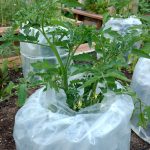
Spinach Start
Q: Can I plant now?
A: It depends!
Yay! Warm days remind us that the threat of frost will soon be gone! If you’re planting hardy perennials, shrubs, vines, grasses or trees, you’re good to go now (as long as your soil isn’t too wet to work). Our stock of seeds and starts for cool-season greens like arugula, spinach, chard, kale and lettuce are in and ready to plant. And you can get a head start on tomatoes!
 We’ve been asked by many customers ‘Is it safe to plant tomatoes (or peppers, eggplants, cucumbers, beans, basil, annual flowers, …) now?’, and we have some answers for you. In general, you’re looking for soil temperatures of 55+ to keep those warm-season plants happy, and you’ll need to be prepared to protect them from sudden late freezes. The average last frost date for Boulder and Metro Denver is May 9th, right around Mother’s Day. But that’s no guarantee – this is Colorado, after all!
We’ve been asked by many customers ‘Is it safe to plant tomatoes (or peppers, eggplants, cucumbers, beans, basil, annual flowers, …) now?’, and we have some answers for you. In general, you’re looking for soil temperatures of 55+ to keep those warm-season plants happy, and you’ll need to be prepared to protect them from sudden late freezes. The average last frost date for Boulder and Metro Denver is May 9th, right around Mother’s Day. But that’s no guarantee – this is Colorado, after all!
The answers depend on your elevation and the microclimate of your garden. Is your yard in a low spot, at the base of a hill, on the north face of a hill? If so, it may take a bit longer for your site to warm up. Air temperature is important, but soil temperature is at just as critical (yes, we sell soil thermometers). Folks gardening in the hills will have a somewhat longer wait and our friend Penn Parmenter of Miss Penn’s Mountain Seeds offers some good advice for you.
June 1st is a magical date for mountain gardeners. This is the day we can almost be sure we can plant seedlings in the open garden. We like to say we have a 90-day season and some of us a moderate elevations 8,000 ft. even do – sometimes.
What is a long-season vegetable? 120 days to maturity is a long season vegetable – like a gourd, sweet potato or winter squash while a summer squash can be only 50-60 days and a radish is 21-30 days; these are considered short season. Mountain gardeners look for 90-day or less in everything from radish’s to pumpkins.
Plants often grow slower at high-elevation, so give them every chance to succeed by allowing extra time … grow small or medium sized tomatoes rather than large beefsteak varieties.
You CAN get a head start with tomatoes with a tool we love – our Solar Caps.
 Solar Caps consist of a sturdy welded galvanized steel wire frame that lasts for years, over which you drape the water-filled plastic bag that comes with the kit. By positioning the Solar Cap where your tomato (or other warm-season veggies) will be planted, in 5-7 days your soil will be warm enough for planting (55+ F). Following planting, Solar Caps form a personal greenhouse for your veggies, which improves growth throughout the season and won’t tip over or collapse. They protect plants from drastic spring temperature fluctuations and from nightly cooling. We leave the Solar caps on our tomatoes though the season, enlarging the opening in the top from a small slit at first to a fully open circle when plants have put on height and weather is consistently warm. We’ve had great success using them for many years and regularly plant our tomatoes by April 15! Check-out Eve’s step-by-step demonstration of putting together your Solar Cap!
Solar Caps consist of a sturdy welded galvanized steel wire frame that lasts for years, over which you drape the water-filled plastic bag that comes with the kit. By positioning the Solar Cap where your tomato (or other warm-season veggies) will be planted, in 5-7 days your soil will be warm enough for planting (55+ F). Following planting, Solar Caps form a personal greenhouse for your veggies, which improves growth throughout the season and won’t tip over or collapse. They protect plants from drastic spring temperature fluctuations and from nightly cooling. We leave the Solar caps on our tomatoes though the season, enlarging the opening in the top from a small slit at first to a fully open circle when plants have put on height and weather is consistently warm. We’ve had great success using them for many years and regularly plant our tomatoes by April 15! Check-out Eve’s step-by-step demonstration of putting together your Solar Cap!


Finally, here are some simple date guidelines for planting vegetables:
PLANTING BY THE HOLIDAYS – THE TRADITIONAL APPROACH
ST. PATRICK’S DAY (thaw to mid-March)
Soil temp: 35-40˚F
Cold-Season: very frost tolerant
Broccoli, cabbage, kohlrabi, onion, lettuce, peas, radish, spinach, turnips, Brussels sprouts
SPRING EQUINOX (mid-March to mid-April)
Soil temp: 40-45˚F
Cool-Season: mild frost tolerance
Beets, carrots, parsley, perennial herbs, parsnips, potatoes, Swiss chard, asparagus, rhubarb

Glacier tomato. Credit Fedco Seeds
MOTHER’S DAY (mid-May)
Soil temp: ~50˚F +
Tender Vegetables: no frost
Beans, celery, corn, cucumbers (seed), summer squash (seed), tomatoes with row cover or Solar Caps
MEMORIAL DAY (late-May to June)
Soil temp: 55˚F or more
Hot Weather Vegetables: no frost; hot days preferred
Cucumbers, summer squash, melons, eggplant, pepper, tomatoes, pumpkin, winter squash, okra
